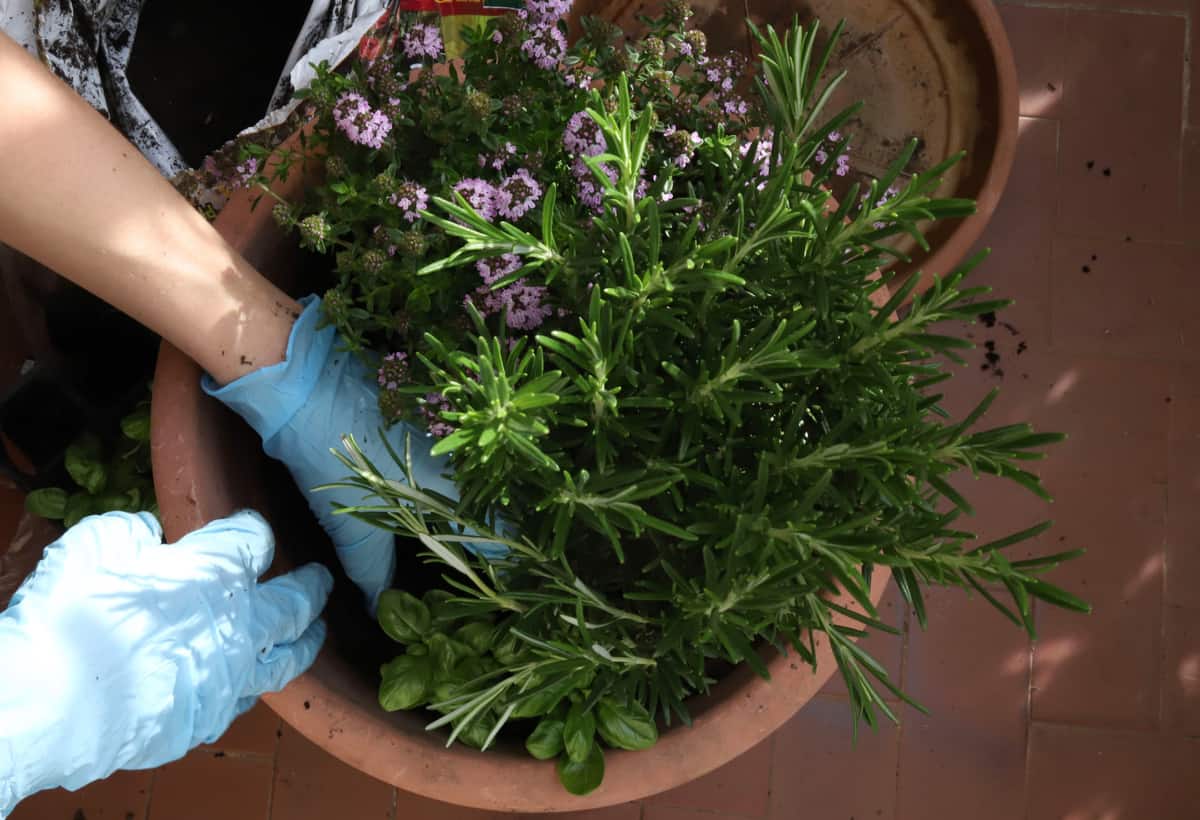Some flowers that grow well with rosemary are lavender, marigold, and chamomile. All of these plants have a strong scent which can help repel pests. Rosemary also does well with other herbs such as thyme, oregano, and basil.
If you’re looking for a beautiful and fragrant herb to add to your garden, look no further than rosemary! This versatile herb can be used in cooking, as a decoration, and even has some health benefits. Best of all, it’s easy to grow and can thrive in many different types of soil and climates.
When planting rosemary, it’s a good idea to mix it with other herbs or flowers. This will not only make your garden more visually appealing, but will also help the rosemary to grow stronger. Some great plants to pair with rosemary are lavender, sage, thyme, and oregano.
All of these herbs have similar growing requirements and prefer full sun exposure. Plus, they’ll all release their lovely fragrance when brushed against or disturbed – making your garden smell amazing!
Rosemary Growth, growing and care tips! (companion planting, uses, origins)
What to Plant With Rosemary in Container
Rosemary is a fragrant, woody herb that is popular in many cuisines. It can be used fresh or dried, and has a strong flavor that goes well with many other herbs and spices. Rosemary can also be used as a decoration, adding a touch of green to any space.
If you’re growing rosemary in a container, there are a few things to keep in mind. First, rosemary likes well-drained soil. Be sure to use a pot with drainage holes and water regularly, letting the soil dry out between watering.
Second, rosemary needs full sun to thrive – at least six hours of direct sunlight per day. If your plant isn’t getting enough light, it will become leggy and produce fewer leaves.When it comes to what to plant with rosemary in a container, there are several options.
Try pairing it with other herbs like thyme or oregano for an aromatic kitchen garden. Or mix in some annuals or perennials for color and texture contrast – think impatiens or petunias for blooms, or sedum for groundcover. Just make sure whatever you choose can handle the same sun and water requirements as rosemary!
What Not to Plant With Rosemary
When it comes to planting rosemary, there are a few things you should avoid. Here is a list of what not to plant with rosemary:
1. Fennel – These two plants can compete for space and nutrients, so it’s best to keep them separate.
2. Beets – Both of these plants love nitrogen, so they can compete for this essential nutrient.
3. Sage – Rosemary and sage can both become invasive, so it’s best to plant them in different areas of the garden.
4. Cabbage – Cabbage and rosemary can also compete for nitrogen, so it’s best to keep them apart.
What Herbs to Plant With Rosemary
Rosemary is a fragrant, evergreen herb that is popular in many cuisines around the world. It is native to the Mediterranean region and has been used for centuries in cooking and herbal medicine. Rosemary can be grown as an annual or perennial plant, and it thrives in full sun and well-drained soil.
When planting rosemary, it is important to choose a spot that receives plenty of sunlight and has good drainage. Rosemary can also be grown in containers if necessary.When it comes to herbs, rosemary goes especially well with thyme, oregano, sage, and lavender.
All of these herbs are also native to the Mediterranean region and share similar growing conditions. Planting these herbs together will create a beautiful and fragrant garden that will be perfect for cooking or drying herbs for later use. Rosemary can also be planted with other sun-loving plants such as cosmos, marigolds, impatiens, and zinnias.
Plants Like Rosemary
Rosemary is a plant that is known for its aromatic, needle-like leaves. It is native to the Mediterranean region and has been used since ancient times for culinary and medicinal purposes. The name rosemary comes from the Latin word rosmarinus, which means “dew of the sea”.
Rosemary belongs to the mint family (Lamiaceae), which includes other popular herbs such as basil, oregano, and thyme.There are two main types of rosemary plants: those with upright stems (known as erecta) and those with trailing stems (known as procumbens). The erecta variety is more commonly grown in gardens, although both types are widely available at nurseries and garden centers.
Rosemary plants can reach up to 6 feet in height and width, but they are often pruned to maintain a smaller size.Rosemary leaves are used fresh or dried in many different cuisines around the world. They have a strong, pungent flavor that goes well with meats, stews, soups, and sauces.
Rosemary also has a long history of use in traditional medicine. It was once believed to have mystical powers and was used in love spells and potions.
Rosemary Companion Vegetables
As its name suggests, rosemary is a wonderful companion to many vegetables. Its strong, woody flavor pairs well with earthy root vegetables like potatoes, carrots, and turnips. It also complements the sweetness of squash and pumpkin.
Rosemary can be used fresh or dried, and it’s easy to grow your own at home.If you’re looking for new ways to spruce up your veggie dishes, give rosemary a try. Here are some of our favorite combinations:
-Rosemary and potatoes: Roast diced potatoes with olive oil, sea salt, and chopped rosemary for a simple yet delicious side dish.-Rosemary and carrots: Add some chopped rosemary to your next batch of roasted carrots for a fragrant twist.-Rosemary and squash: Season roasted winter squash with sage and rosemary for a warm and flavorful dish.
Rosemary And Strawberry Companion Plants
If you’re looking for some great companion plants for your roses, why not try strawberries? Rosemary and strawberries are a perfect match, and they’ll help keep your roses healthy and happy.Rosemary is an evergreen shrub that grows to about 3 feet tall.
It has narrow, dark green leaves and tiny blue flowers. Rosemary is native to the Mediterranean region, so it loves sunny, dry conditions. When grown with roses, rosemary acts as a natural pest repellent.
It also helps improve drainage around the roots of your roses, which can help prevent problems like root rot.Strawberries are small red fruits that grow on runners (or stolons). They’re members of the rose family, so they make a good companion plant for roses.
Strawberries provide essential nutrients that roses need for healthy growth. They also help improve drainage around the roots of your roses and protect them from pests like slugs and snails.
Rosemary And Peppers Companion Plants
If you’re looking to add a little flavor to your garden, then why not try planting some rosemary and peppers together? These two companion plants can really spice things up!Rosemary is a fragrant herb that’s often used in cooking.
It has a strong, woody aroma and can be used fresh or dried. Peppers are a versatile vegetable that come in many different colors and sizes. They can be enjoyed raw, cooked, or pickled.
When planted together, these two companions can really enhance the flavors of each other. The rosemary will help keep the peppers from getting too spicy, while the peppers will add a touch of sweetness to the rosemary. Together, they make a delicious duo!
Rosemary And Tomato Companion Plants
If you’re looking to add some flavor to your garden, why not try planting rosemary and tomatoes together? These two companion plants are a match made in heaven, and they’ll provide you with an abundance of delicious herbs and vegetables all season long. Here’s everything you need to know about growing these two plants side-by-side.
Rosemary is a hardy evergreen shrub that can reach up to 6 feet in height. It has narrow, needle-like leaves that are dark green in color. The plant produces small, blue flowers that bloom in the springtime.
Rosemary is native to the Mediterranean region and prefers full sun and well-drained soil.Tomatoes are warm-season annuals that can grow anywhere from 2-6 feet tall (depending on the variety). They have glossy, green leaves and produce red (or yellow) fruits that are typically ripe in the summertime.
Tomatoes like full sun and rich, loamy soil.When planting rosemary and tomatoes together, it’s best to put them both in an area of your garden that receives full sun for at least 6 hours per day. If possible, choose a spot where the soil drains well – rosemary doesn’t like wet or soggy conditions.
To prepare the bed for planting, mix some compost into the top few inches of soil to help improve drainage and fertility.Plant your tomato seedlings first, spacing them 18-24 inches apart depending on the variety you’re growing. Then, place your rosemary plants around the perimeter of the bed (you can also tuck them in between tomato plants if you’d like).


Can Rosemary Grow With Other Plants?
Yes, rosemary can grow with other plants! In fact, it’s a great companion plant for many different types of plants. Rosemary can help to repel pests and improve the health of other plants.
It’s also a good idea to grow rosemary with plants that have similar growing conditions, such as full sun and well-drained soil.
Can You Use Rosemary With Flowers on It?
If you’re looking to add a bit of flavor to your floral arrangement, rosemary is a great option! This herb can be used fresh or dried, and has a strong, woodsy aroma. When using rosemary with flowers, be sure to strip the leaves from the stem so that only the leafy part is in contact with the water.
Otherwise, the stem will release too much of its oils and make the arrangement taste bitter.
Can Lavender And Rosemary Be Planted Together?
Lavender (Lavandula) and rosemary (Rosmarinus officinalis) are both evergreen herbs that are popular in cooking and gardening. They can be planted together, but there are a few things to consider before doing so.Lavender prefers full sun and well-drained soil, while rosemary prefers partial sun and moist, but not wet, soil.
When planting them together, make sure to give the lavender more sun than the rosemary. It’s also a good idea to plant them in separate pots or beds so that you can control the soil moisture better.If you live in an area with hot summers, it’s best to plant lavender in early spring or fall and rosemary in late spring or early summer.
This will help the plants acclimate better and prevent them from getting too stressed in the heat.When harvesting your herbs, always cut back lavender first since it blooms on new growth. You can then cut back the rosemary if needed.
These two herbs go well together in many recipes, so enjoy using them fresh from your garden!
Where Should Rosemary Be Planted in the Garden?
Rosemary is a perennial herb that is native to the Mediterranean. It is a member of the mint family and has a woody, evergreen aroma. The leaves are used to flavor many dishes, including roast lamb, chicken, and fish.
Rosemary can also be used as a decoration in the garden.Where should rosemary be planted in the garden?Rosemary thrives in full sun and well-drained soil.
It is tolerant of drought and salt spray, making it an ideal plant for seaside gardens. When grown in pots, rosemary should be repotted every two to three years.
Conclusion
Rosemary is a versatile herb that can be used in many different dishes. It has a strong flavor, so it is best to use it sparingly. Rosemary goes well with other herbs such as thyme, oregano, and basil.
It can also be used in soups, stews, and sauces. Rosemary can be dried or fresh. When using fresh rosemary, it is best to add it towards the end of cooking so that its flavor does not become too overpowering.






